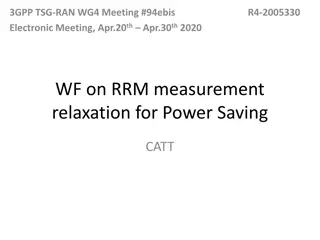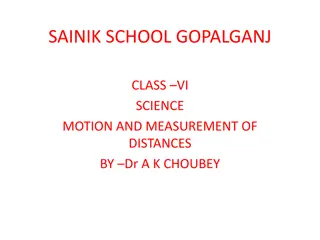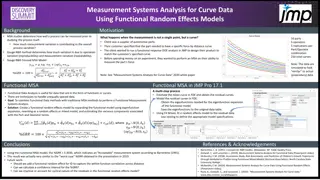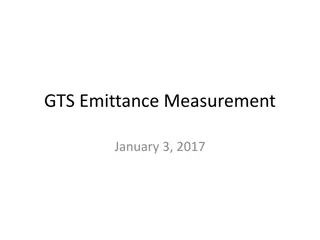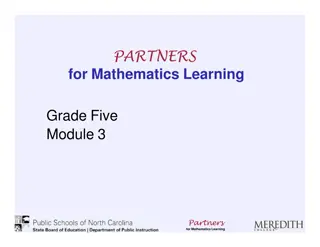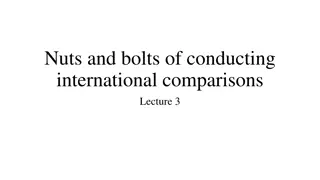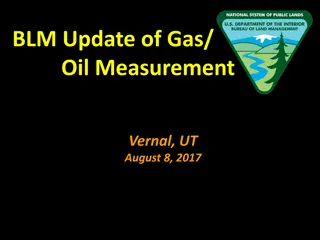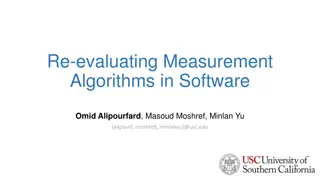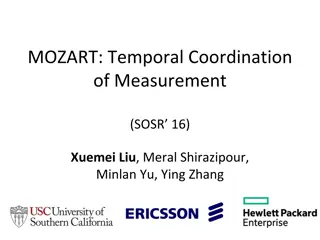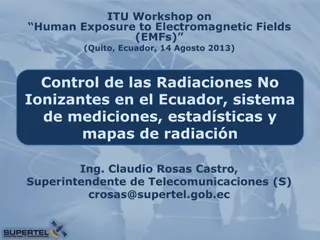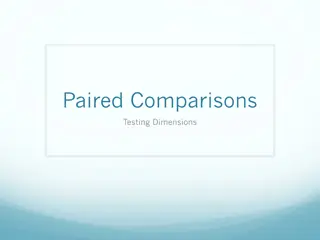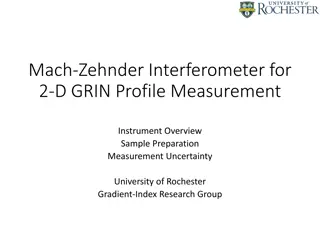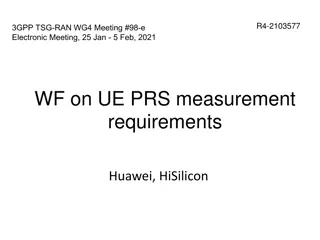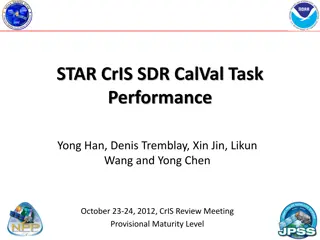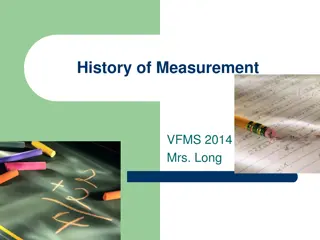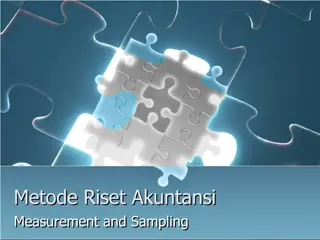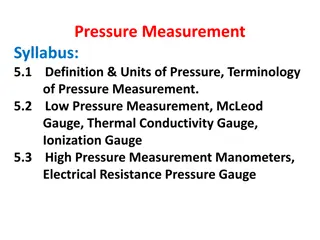Significance of Measurement Comparisons
Measurements involve comparisons, leading to uncertainty and the need for estimation between scale divisions. Accuracy in measurement is crucial, as seen in examples such as determining the length of a beetle's body. Estimating the middle value in a range is common practice when expressing measurements as a single number. Different rulers can yield slightly different results, highlighting the importance of precision in measurement processes.
Download Presentation

Please find below an Image/Link to download the presentation.
The content on the website is provided AS IS for your information and personal use only. It may not be sold, licensed, or shared on other websites without obtaining consent from the author. Download presentation by click this link. If you encounter any issues during the download, it is possible that the publisher has removed the file from their server.
E N D
Presentation Transcript
Significance in Measurement Measurements always involve a comparison. When you say that a table is 6 feet long, you're really saying that the table is six times longer than an object that is 1 foot long. The foot is a unit; you measure the length of the table by comparing it with an object like a yardstick or a tape measure that is a known number of feet long. L Chedid 2008
Significance in Measurement The comparison always involves some uncertainty. If the tape measure has marks every foot, and the table falls between the sixth and seventh marks, you can be certain that the table is longer than six feet and less than seven feet. To get a better idea of how long the table actually is , though, you will have to read between the scale division marks. This is done by estimating the measurement to the nearest one tenth of the space between scale divisions. L Chedid 2008
Significance in Measurement Which of the following best describes the length of the beetle's body in the picture to the left? a) Between 0 and 2 in b) Between 1 and 2 in c) Between 1.5 and 1.6 in d) Between 1.54 and 1.56 in e) Between 1.546 and 1.547 in L Chedid 2008
Significance in Measurement The correct answer is . . . (d), between 1.54 and 1.56 inches L Chedid 2008
Significance in Measurement Measurements are often written as a single numberrather than a range. The beetle's length in the previous frame was between 1.54 and 1.56 inches long. The single number that best represents the measurement is the center of the range, 1.55 inches. When you write the measurement as a single number, it's understood that the last figure (the second of the two 5 s in this case) had to be estimated. Consider measuring the length of the same object with two different rulers. L Chedid 2008
Significance in Measurement For each of the rulers, give the correct length measurement for the steel pellet as a single number rather than a range L Chedid 2008
Significance in Measurement For the ruler on the left you should have had . . . 1.4 in For the ruler on the right, you should have had . . . 1.47 in L Chedid 2008
Significance in Measurement A zero will occur in the last placeof a measurement if the measured value falls exactly on a scale division. For example, the temperature on the thermometer should be recorded as 30.0 C. Reporting the temperature as 30 C would imply that the measurement had been taken on a thermometer with scale marks 100 C apart! L Chedid 2008
Significance in Measurement A temperature of 17.00 C was recorded with one of the three thermometers to the left. Which one was it? A) the top one B) the middle one C) the bottom one D) either the top one, or the middle one E) either the middle one, or the bottom one F) it could have been any of them L Chedid 2008
Significance in Measurement The correct answer is . . . D This is the best choice because . . . The top thermometer reads to 0.1 so 0.01 can be estimated The middle thermometer reads to 0.2 so 0.02 can be estimated In both cases, a reading of 17.00 is possible L Chedid 2008
Significance in Measurement Use the bottom of the meniscus (the curved interface between air and liquid) as a point of reference in making measurements of volume in a graduated cylinder, pipet, or buret. In reading any scale, your line of sight should be perpendicular to the scale to avoid 'parallax' reading errors. L Chedid 2008
Significance in Measurement Determine the volume readings for the two cylinders to the right, assuming each scale is in mL. L Chedid 2008
Significance of Measurement Numbers obtained by counting have no uncertainty unless the count is very large. For example, the word 'sesquipedalian' has 14 letters. "14 letters" is not a measurement, since that would imply that we were uncertain about the count in the ones place. 14 is an exact number here. L Chedid 2008
Significance in Measurement Numbers obtained from definitions have no uncertainty unless they have been rounded off. For example, a foot is exactly 12 inches. The 12 is not uncertain at all. A foot is also exactly 30.48 centimeters from the definition of the centimeter. The 8 in 30.48 is not uncertain at all. But if you say 1 foot is 30.5 centimeters, you've rounded off the definition and the rounded digit is uncertain. L Chedid 2008
Significance in Measurement You should have picked choices . . . 1, 2 and 4 Choices 3 and 5 are incorrect because both are counts are very large. Recall that very large counts have uncertainty because of inherent flaws in the counting process. L Chedid 2008
Significance in Measurement All of the digits up to and including the estimated digit are calledsignificant digits. Consider the following measurements. The estimated digit is in gold: Measurement Number of Distance Between Markings Significant Digits on Measuring Device 142.7 g 4 103 nm 3 2.99798 x 108 m 6 0.0001 x 108 m 1 g 10 nm L Chedid 2008
Significance in Measurement A sample of liquid has a measured volume of 23.01 mL. Assume that the measurement was recorded properly. How many significant digits does the measurement have? 1, 2, 3, or 4? The correct answer is . . . 4 L Chedid 2008
Significance in Measurement Suppose the volume measurement was made with a graduated cylinder. How far apart were the scale divisions on the cylinder, in mL? 10 mL, 1 mL, 0.1 mL, or 0.01 mL? The correct answer is . . . 0.1 mL L Chedid 2008
Significance in Measurement Which of the digits in the measurement is uncertain? The 2, 3, 0, or 1? The correct answer is . . . 1 L Chedid 2008
Significance in Measurement Usually one can count significant digits simply by countingall of the digits up to and including the estimated digit. It's important to realize, however, that the position of the decimal point has nothing to do with the number of significant digits in a measurement. For example, you can write a mass measured as 124.1 g as 0.1241 kg. Moving the decimal place doesn't change the fact that this measurement has FOUR significant figures. L Chedid 2008
Significance in Measurement Suppose a mass is given as 127 ng. That's 0.127 g, or 0.000127 mg, or 0.000000127 g. These are all just different ways of writing the same measurement, and all have the same number of significant digits: THREE. L Chedid 2008
Significance in Measurement If significant digits are all digits up to and including the first estimated digit, why don't those zeros count? If they did, you could change the amount of uncertainty in a measurement that significant figures imply simply by changing the units. Say you measured 15 mL The 10 s place is certain and the 1 s place is estimated so you have 2 significant digits If the units to are changed to L, the number is written as 0.015 L If the 0 s were significant, then just by rewriting the number with different units, suddenly you d have 4 significant digits L Chedid 2008
Significance in Measurement By not counting those leading zeros, you ensure that the measurement has the same number of figures (and the same relative amount of uncertainty) whether you write it as 0.015 L or 15 mL L Chedid 2008
Significance in Measurement Determine the number of significant digits in the following series of numbers: 0.000341 kg = 0.341 g = 341 mg 12 g = 0.000012 g = 0.000000012 kg 0.01061 Mg = 10.61 kg = 10610 g L Chedid 2008
Significance in Measurement You should have answered as follows: 3 2 4 L Chedid 2008
Significance in Measurement How can you avoid counting zeros that serve merely to locate the decimal point as significant figures? Follow this simple procedure: Move the decimal point so that it is just to the right of the first nonzero digit, as you would in converting the number to scientific notation. Any zeros the decimal point moves past are not significant, unless they are sandwiched between two significant digits. All other figures are taken as significant. L Chedid 2008
Significance in Measurement Any zeros that vanish when you convert a measurement to scientific notation were not really significant figures. Consider the following examples: 0.01234 kg 1.234 x 10-2 kg 4 sig figs Leading zeros (0.01234 kg) just locate the decimal point. They're never significant. L Chedid 2008
Significance in Measurement 0.012340 kg Notice that you didn't have to move the decimal point past the trailing zero (0.012340 kg) so it doesn't vanish and so is considered significant. 1.2340 x 10-2 kg 5 sig figs 0.000011010 m Again, the leading zeros vanish but the trailing zero doesn't. 1.1010 x 10-5 m 5 sig figs L Chedid 2008
Significance in Measurement 0.3100 m Once more, the leading zeros vanish but the trailing zero doesn't. 3.100 x 10-1 m 4 sig figs 321,010,000 miles Ignore commas. Here, the decimal point is moved past the trailing zeros (321,010,000 miles) in the conversion to scientific notation. They vanish and should not be counted as significant. The first zero (321,010,000 miles) is significant, though, because it's wedged between two significant digits. 3.2101 x 108 miles 5 sig figs L Chedid 2008
Significance in Measurement 84,000 mg The decimal point moves past the zeros (84,000 mg) in the conversion. They should not be counted as significant. 8.4 x 104 mg 2 sig figs 32.00 ml The decimal point didn't move past those last two zeros. 3.200 x 101 ml 4 sig figs L Chedid 2008
Significance in Measurement 302.120 lbs The decimal point didn't move past the last zero, so it is significant. The decimal point did move past the 0 between the two and the three, but it's wedged between two significant digits, so it's significant as well. All of the figures in this measurement are significant 3.02120 x 102 lbs 6 sig figs L Chedid 2008
Significance in Measurement When are zeros significant? From the previous slide, you know that whether a zero is significant or not depends on just where itappears. Any zero that serves merely to locate the decimal point is not significant. L Chedid 2008
Significance in Measurement All of the possibilities are covered by the following rules: 1. Zeros sandwiched between two significant digits are always significant. 1.0001 km 2501 kg 140.009 Mg 5, 4, 6 L Chedid 2008
Significance in Measurement 2. Trailing zeros to the right of the decimal point are always significant. 3.0 m 12.000 m 1000.0 m 2, 5, 5 3. Leading zeros are never significant. 0.0003 m 0.123 m 0.0010100 m 1, 3, 5 L Chedid 2008
Significance in Measurement 4. Trailing zeros that all appear to the LEFT of the decimal point are not assumed to be significant. 3000 m 1230 m 92,900,000 miles 1, 3, 3 L Chedid 2008
Significance in Measurement Rule 4 covers an ambiguous case. If the zero appears at the end of the number but to the left of the decimal point, we really can't tell if it's significant or not. Is it just locating the decimal point or was that digit actually measured? For example, the number 3000 m could have 1, 2, 3, or 4 significant figures, depending on whether the measuring instrument was read to the nearest 100, 10, or 1 meters, respectively. You just can't tell from the number alone. All you can safely say is that 3000 m has at least 1 significant figure. L Chedid 2008
Significance in Measurement The writer of the measurement should use scientific notation to remove this ambiguity. For example, if 3000 m was measured to the nearest meter, the measurement should be written as 3.000 x 103 m. L Chedid 2008
Significance in Measurement How many significant figures are there in each of the following measurements? 1010.010 g 32010.0 g 0.00302040 g 0.01030 g 101000 g 100 g 7, 6, 6, 4, 3, 1 L Chedid 2008
Significance in Measurement Rounding Off Often a recorded measurement that contains more than one uncertain digit must be rounded off to the correct number of significant digits. For example, if the last 3 figures in 1.5642 g are uncertain, the measurement should be written as 1.56 g, so that only ONE uncertain digit is displayed. L Chedid 2008
Significance in Measurement Rules for rounding off measurements: 1. All digits to the right of the first uncertain digit have to be eliminated. Look at the first digit that must be eliminated. 2. If the digit is greater than or equal to 5, round up. 1.35343 g rounded to 2 figures is 1.4 g. 1090 g rounded to 2 figures is 1.1 x 103 g. 2.34954 g rounded to 3 figures is 2.35 g. L Chedid 2008
Significance in Measurement 3. If the digit is less than 5, round down. 1.35343 g rounded to 4 figures is 1.353 g. 1090 g rounded to 1 figures is 1 x 103 g. 2.34954 g rounded to 5 figures is 2.3495 g. Try these: 2.43479 rounded to 3 figures 1,756,243 rounded to 4 figures 9.973451 rounded to 2 figures L Chedid 2008
Significance in Measurement The correct answers are . . . 2.43 1.756 x 106 1.0 x 101 L Chedid 2008
Significance in Measurement L Chedid 2008






